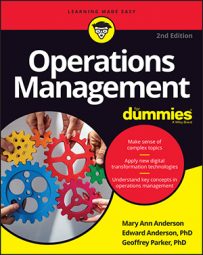Your business will become more efficient as a whole if you can improve your operations management behind the scenes. For the most part, anything that the customer doesn’t have to be directly involved in should be optimized only for business efficiency. When a customer takes a check to the bank for deposit, he’s unconcerned about how the money gets credited to his account — only that it does.
When designing back-office operations, you want a smooth flow of material through the process, and you want the process to be easy to control and monitor.
Design these processes with these guidelines:
Utilize a sequential flow pattern in the process. You want the material to flow through the process in sequence, from station to station. Facilities, especially in manufacturing, often utilize a U-shaped design. The process begins and ends at the front of the facility. This arrangement allows a manager to observe the process over a small, confined space, making it easy to control. This also facilitates good communication among workers.
Minimize backtracking of work in the process. Sending parts back in the process can create confusion because tracing the part in the process may become difficult; it can also impede the movement of other parts in the process. If material needs to backtrack, then maintain separate inboxes for the first-time material and returned material, or implement a marking system to distinguish the two.
Implement a predictable process. If possible, all parts should progress through the process in the same steps. Aim to remove any decisions on the operator’s part. If the process has decision points, then every part meeting the same criteria should go through the same predictable path.
Reduce material movement. Material movement is a non-value-added activity that takes time and can lead to parts getting lost or ending up at the wrong locations. In addition, unnecessary movement can create safety concerns, especially in cases where equipment is required to move parts from place to place.
Emphasize bottleneck management. A bottleneck is the operation that limits a system’s overall capacity. Design processes to maximize utilization of the bottleneck.
Minimize inventory. Inventory takes up space in your process, and you can reduce the size of your facility by reducing it. Some inventory is necessary to allow smooth operations, but too much can interfere with the smooth flow of material through the process.
Create an open environment. An open environment allows everyone to see what’s going on in the process and simplifies the job of managing. It exposes problems in the process because there’s nowhere to hide. This applies to manufacturing operations and office environments. An open environment can also increase communication among employees because everyone can see the state of the operation.
Maintain flexibility. A facility design should be flexible to allow for new conditions. If possible, you should be able to reconfigure the design to accommodate the introduction of new products or a change in the mix of products produced or processed at the facility.
The processes that take place out of the sight of the customer are prime for taking advantage of economies of scale. In a bank, centralizing such things as the loan decision process is common, and in fast food restaurants, employees form the hamburger patties and cut the potatoes into French fries at a central location that supplies several restaurants.

